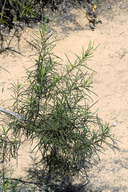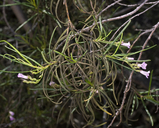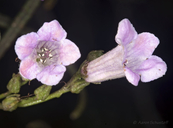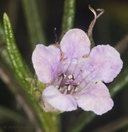notes Habitus shot of the largest and presumably oldest Eriodictyon altissimum seen in my (non-exhaustive!) search for individuals of the species at the main Los Osos and Indian Knob populations. This species was originally described by P. V. Wells in 1962. It is very rare and listed as federally endangered. From the species descriptions for Eriodictyon in the Jepson Manual it is the tallest known species in the genus (up to 4 meters)...and that was no doubt the reason for Wells choice of the specific epithet altissimum: from the Latin root ''alti-'' (= high, tall) + ''-issimum'' (= superlative ending; most). The individual seen here was near 4 m high...certainly the tallest, most gangling, and woody-branched Eriodictyon plant I've ever seen. With its long arching branches and dense dangling clusters of narrowly-linear leaves it definitely has a Dr. Seuss quality.
In its very few stations E. altissimum grows along somewhat open edges of chaparral on sandy or sandstone substrates, where germination of its seedlings presumably benefits from the occurrence of (non-catastrophic) chaparral fires...which initially provide local soil disturbance for seed burial, enhanced soil characteristics, and relative lack of competition for sunlight, soil moisture, and nutrients. Like other Eriodictyon species, E. altissimum is rhizomatous, so established plants can also propagate by runners.
Those familiar with the widespread and common species E. californicum may notice that...like that species...this one also appears to suffer from regular occurrences of black sooty mold, which can be seen on leaves in a number of photos I've posted in this series. I'm curious as to which of the 10 currently circumscribed species of Eriodictyon typically support regular occurrences of such black sooty mold communities (which consist of multiple fungal species that feed on ''honeydew'' exudate from a diverse collection of small, plant-feeding true-bugs in the order Hemiptera). I'm also curious as to whether the degree of infestation by the black sooty molds is linked to the frequency (or lack thereof) of fire in the chaparral community.












